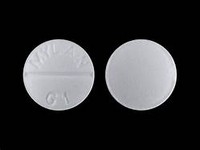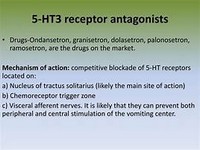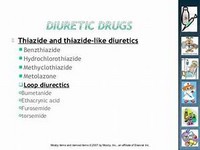Clomipramine hydrochloride

Clomipramine hydrochloride
CLINICAL USE
Depressive illness Phobic and obsessional states Adjunctive treatment of cataplexy associated with narcolepsyDOSE IN NORMAL RENAL FUNCTION
10–250 mg dailyCataplexy: 10–75 mg dailyPHARMACOKINETICS
DOSE IN RENAL IMPAIRMENT
GFR (mL/MIN)
DOSE IN PATIENTS UNDERGOING RENAL REPLACEMENT THERAPIES
IMPORTANT DRUG INTERACTIONS
Potentially hazardous interactions with other drugsAlcohol: increased sedative effect Analgesics: increased risk of CNS toxicity with tramadol; possibly increased risk of side effects with nefopam; possibly increased sedative effects with opioidsAnti-arrhythmics: increased risk of ventricular arrhythmias with amiodarone – avoid concomitant use; increased risk of ventricular arrhythmias with drugs that prolong the QT interval; increased risk of arrhythmias with propafenoneAntibacterials: increased risk of ventricular arrhythmias with moxifloxacin – avoid concomitant use; concentration possibly reduced by rifampicinAnticoagulants: may alter anticoagulant effect of coumarinsAntidepressants: possibly increased serotonergic effects with duloxetine; enhanced CNS excitation and hypertension with MAOIs and moclobemide; concentration possibly increased with SSRIsAnti-epileptics: convulsive threshold lowered; concentration reduced by carbamazepine, primidone, barbiturates and possibly phenytoinAntimalarials: avoid concomitant use with artemether/lumefantrineAntipsychotics: increased risk of ventricular arrhythmias especially with pimozide; increased antimuscarinic effects with clozapine and phenothiazines; concentration increased by antipsychoticsAntivirals: increased tricyclic side effects with amprenavir; concentration possibly increased with ritonavirAtomoxetine: increased risk of ventricular arrhythmias and possibly convulsionsBeta-blockers: increased risk of ventricular arrhythmias with sotalolClonidine: tricyclics antagonise hypotensive effect; increased risk of hypertension on clonidine withdrawalDopaminergics: avoid use with entacapone; CNS toxicity reported with selegiline and rasagilinePentamidine: increased risk of ventricular arrhythmiasSibutramine: increased risk of CNS toxicity – avoid concomitant use. Sympathomimetics: increased risk of hypertension and arrhythmias with adrenaline and noradrenaline; metabolism possibly inhibited by methylphenidateClomipramine hydrochloride.ADMINISTRATION
Reconstition
–Route
OralRate of Administration
–Comments
–OTHER INFORMATION
Normal doses have been used in dialysis patients long term, but caution as parent drug and active metabolites may accumulate
See how to identify renal failure stages according to GFR calculation
See how to diagnose irreversible renal disease
Home








